The Apollonian-Dionysian Continuum in Cognition and Perception
How each of us is relatively more adapted for "order" or "chaos". Chapter 7 of my upcoming book The Return of the Great Mother
Below I am going to reproduce most of Chapter 7 of my upcoming book The Return of the Great Mother. In terms of technicality, this is probably the most difficult chapter I’ve written so far. It was difficult for me to fully grasp the implications of precision-weighting when I was first exploring these ideas five years ago, and it will probably be just as difficult for people who are encountering them for the first time through my writing.
I have tried to use a number of metaphors and images to make the implications of precision-weighting more intuitive, but the chapter as a whole will probably still be difficult to grasp for the uninitiated.
Nevertheless, the ideas in this chapter will play an especially important role for the rest of the book. I will continue to edit and refine them to make them as intuitive as possible. If you have any suggestions about that while reading, I’m all ears.
I’m currently finishing up the draft of Chapter 19 of the book and am on schedule to have it edited and released by the end of next summer.
As with previous chapters I’ve released on Substack (Chapter 1 and Chapter 6), I haven’t spent too much time cleaning up the citations here. They will be fixed when I am editing the book for release. I’ve lightly edited this for Substack, but for the most part it is the same as my current draft of the chapter.
-Brett
Chapter 7: The Autism-Schizotypy Continuum
I say unto you: one must still have chaos in oneself to be able to give birth to a dancing star. I say unto you: you still have chaos in yourselves.
(Nietzsche, Zarathustra Prologue)
In the last chapter, we saw that our brains are constantly balancing opposing demands—between focus and openness, specialization and generalization, efficiency and resiliency. These trade-offs are foundational to how we perceive, think, and act. But there’s a catch: no matter how skillfully we navigate these tensions, it will always be impossible to know in advance which strategy will prove optimal.
For example, imagine that you are an ancient hunter-gatherer who has lived your whole life in a single fertile valley. You learn how to catch crawfish in the local river, how to smoke out bees to gather honey, and how to track the local game with intuition and precision. Your knowledge is deep and tightly attuned to your environment. Then, the unthinkable happens. A nearby volcano erupts, blanketing your valley with ash and molten rock. The sky darkens. Plants wither. Animals vanish. You and your group are forced to leave in search of more hospitable ground. You cross foothills and dry plains until, at last, you reach a modest oasis. But the world here is different. The animals behave strangely. The plants are unfamiliar. Your well-honed expertise, so effective in your old home, now has limited value. Your knack for catching crawfish means little in a place with none. Much of what you’ve learned over the course of a lifetime has become obsolete.
Now, you and your family’s survival will largely depend on how well you can generalize. Can you take what you learned in a previous context and apply the same principles to a new, unfamiliar context? In periods of upheaval, generalists thrive while specialists are left behind.
But what if that volcano never erupted? What if you actually got to spend your whole life in that stable fertile valley? In that case, being a generalist would be wasteful. In a stable environment, having precise, detailed, specialized cognitive models would serve you well.
There is, of course, no way to know in advance which scenario will actually happen. And that’s the evolutionary dilemma. Some environments reward efficiency, precision, and deep specialization—models that lock tightly onto familiar patterns and squeeze every last drop of value from a stable world. Other environments reward flexibility and broad generalization—models that sacrifice detail for adaptability, capable of applying to many different situations while specializing in none.
Because our ancestors could never be certain which world they would face, evolution didn’t settle on a single solution. Instead, it hedged its bets by producing a spectrum of minds—some optimized for order, others better suited to chaos. Some of us are born specialists: focused, precise, and detail-oriented. Others are born generalists: open, abstract, and exploratory. These aren’t just personality quirks. They are deep cognitive-perceptual styles, shaped by evolutionary trade-offs, and mediated by the brain’s predictive architecture. In this chapter, we’ll explore how these styles manifest in the modern mind, most notably in the diametric traits associated with autism and positive schizotypy.
The Diametric Model of Autism and Psychosis
Autism is a neurodevelopmental disorder characterized by restricted and repetitive behavior, social deficits, and sensory abnormalities (American Psychiatric Association, 2013). High-functioning autism is often accompanied by impressive systemizing skills, meaning that people with autism are often naturally talented at mastering rules-based systems (e.g., a computer programming language; Baron-Cohen et al., 2009). This systemizing tendency can make them excellent engineers, computer programmers, and hard scientists. Importantly, autistic-like traits exist on a continuum such that many high-functioning people who do not meet criteria for an autism diagnosis can be more or less “autistic.” Autistic-like traits generally manifest in nonclinical populations as a tendency to be highly attuned to details, restricted imagination, a preference for predictable routines, strong interest in narrow topics, and strong systemizing skills (Del Giudice, 2018).
Psychosis is often described as a loss of contact with consensus reality. People who are in the throes of psychosis can experience delusions (strange and unlikely beliefs that are held with unshakable confidence), hallucinations (perceptions with no apparent correspondence with reality), and a loss of coherence in thought patterns or speech (Del Giudice, 2018). Although we will come back to acute psychosis at the end of this chapter, the bulk of the chapter will deal with a cluster of traits that can predict psychosis but are not in themselves pathological. There is a cluster of personality traits associated with a predisposition to psychosis called schizotypy. Schizotypy has three factors: Negative schizotypy is characterized by anhedonia (loss of motivation and interest in normally pleasurable activities) and social isolation (Raine, 1991), disorganized schizotypy is characterized by odd thoughts and behaviors (Debbané & Barrantes-Vidal, 2015), and positive schizotypy is characterized by magical thinking (e.g., ascribing supernatural causes to events), ideas of reference (e.g., the idea that seemingly random events have personal significance), and unusual experiences (often described as mystical or paranormal) and is often associated with increased creativity and imagination (Mohr & Claridge, 2015; Raine, 1991).
The theory put forward in this chapter is only concerned with the cognitive, perceptual, and behavioral correlates of positive schizotypy — not with negative or disorganized schizotypy. Below I will make the case, in concert with my 2022 paper Autistic-like Traits and Positive Schizotypy as Diametric Specializations of the Predictive Mind, that autistic traits and positive schizotypy exist on a continuum, and that most of the cognitive, perceptual, and behavioral correlates associated with this continuum can be explained by a single mechanism: differential precision-weighting of sensory input. That claim will be unpacked in more detail later in the chapter.
Difference, Not Dysfunction
Before we go further, it’s important to clear up a likely confusion. The continuum of traits we’ll explore in this chapter — referred to as the autism-schizotypy continuum — is not inherently about disorder or dysfunction. It’s a spectrum of cognitive-perceptual styles that all of us fall somewhere along. There are highly functional people on both ends of this spectrum, just as there are dysfunctions that can emerge at either extreme. Our understanding of this spectrum of traits has largely emerged from the study of pathology—specifically, from research on autism and psychosis-spectrum conditions. These edge cases reveal, in amplified form, the trade-offs that exist across the entire range of human minds. The spectrum itself is not pathological.
When I use the terms “autistic-like traits” and “positive schizotypy” I am not referring to clinical disorders or mental illness, but a spectrum of traits that everyone falls along.
Evaluating the Evidence
Crespi and Badcock’s 2008 diametric model of autism and psychosis is relatively straightforward: they argue that autism-spectrum and psychosis-spectrum conditions are cognitive and genetic opposites. Diametric is just a fancy academic way of saying “oppositely related”. The idea is simple enough. Evaluating the evidence is not.
A common objection to the model is that autism and psychosis sometimes co-occur. If they are opposites, how can the same person be diagnosed with both? The answer lies in the system of psychiatric diagnosis itself. The DSM does not attempt to classify disorders by underlying causes. It only classifies them by surface-level symptoms. Two people can, and often do, show similar symptoms while having entirely different etiologies (i.e., underlying causes).
For example, a person with schizophrenia in remission—someone who is not currently experiencing delusions or hallucinations—may exhibit behaviors that are superficially similar to autistic traits. They might struggle with social reciprocity, engage in repetitive routines, or fixate on unusual interests. These overlapping symptoms can lead to an autism diagnosis, even if the developmental trajectory and underlying mechanisms differ significantly from the typical autistic individual. In theory, autism should only be diagnosed when autistic traits are present from early childhood. In practice, the boundaries are often porous. Diagnostic ambiguity and overextension are not bugs of the DSM—they’re features of a system designed to prioritize classification over explanation. The DSM was never meant to carve nature at its joints. It was not built for scientific research, but for clinical utility—and it makes no pretense otherwise.
This is especially true of the DSM 5, which has broadened the criteria for an autism diagnosis almost to the point of absurdity. Psychiatrist Hannah Spier (on Substack atPsychobabble) comments:
[A] most dramatic change came with DSM-5 in 2013. The subtypes were eliminated. Autism became one spectrum. The criteria were thinned down to two domains: social communication difficulties and restrictive, repetitive behaviours. A person needed to meet just six out of twelve traits, spread across these two clusters. Language and cognitive delay? Optional. Even the requirement for early onset was removed. A diagnosis could now be given based on historical symptoms. Questionnaires like the Autism Spectrum Quotient (AQ) are so broad and subjective they can be easily gamed. This made it possible for 30-year-olds to recall feeling “socially overwhelmed” in school and not liking itchy clothing to receive the same diagnosis as a nonverbal child requiring lifelong care. (September 2025 article)
Autism diagnoses based on DSM 5 criteria ought to be viewed with some suspicion. Luckily, much of the relevant research was done before that.
For all of these reasons, some diagnostic overlap is expected. If we can look past that, the evidence for the diametric model is, in my expert opinion, overwhelming. It’s true that the model is not widely accepted among relevant scientists, but I’m convinced that this is due to hyper-specialization more than anything. Many competent scientists just don’t read much literature outside of their specialized area, and rarely consider evidence outside of that area. But evidence for the diametric model spans everything from the study of semantic networks (how we associate ideas and words) to genomic imprinting (how maternal and paternal genes shape development). The cross-disciplinary nature of the diametric model makes it difficult to assess for the average, hyper-specialized scientist.
Consider this list of diametric traits associated with either side of the continuum. I’ve indicated whether evidence for each diametric trait is strong, controversial, or both, with citations on the side (note that because Substack doesn’t allow tables I’ve had to convert this into images):
In this chapter, I’ll be focusing on cognitive-perceptual and behavioral traits along this spectrum. First, let’s try to assess the evidence for the diametric model. Consider the two options below, assuming that I haven’t mischaracterized the state of the empirical evidence in the table above:
1. All of these diametric traits are moderately to strongly supported by current evidence, but the diametric model as a whole is wrong.
2. All of these diametric traits are moderately to strongly supported by current evidence because autism and psychosis spectrum conditions really are cognitive and genetic opposites.
Given the sheer number of diametrically related traits, and the fact that they show up in so many different research areas, option 2 seems so much more likely to me that it’s hardly worth considering option 1. And so we won’t.
The PSI Hypothesis
In my 2022 paper, I proposed a theory to explain a wide array of cognitive, perceptual, and behavioral traits that appear diametrically related across the autism–schizotypy continuum. This theory was not entirely original, as the same theory had been proposed to explain many different aspects of autism spectrum disorder (Van de Cruys et al., 2014). All I did was extend the theory by showing how well it accounted for traits on the opposite (i.e., positive schizotypy) end of the spectrum.
I called my proposal the precision-weighting of sensory input (PSI) hypothesis. On the surface, the PSI hypothesis is pretty simple: People high in autistic-like traits give a relatively high weight to sensory input while people high in positive schizotypy give a relatively low weight to sensory input. In reality, mapping the consequences of this hypothesis is not always straightforward. Before addressing specific traits, let’s try to make the PSI hypothesis more intuitive.
Many sensory inputs will produce prediction errors—mismatches between the input and what your predictive model says the input should be. We ignore most of these errors because most of them are small and unimportant. But there is a tradeoff: ignore too many errors and you will miss out on important details; pay attention to too many errors and you will get lost in the weeds, missing the big picture for the sake of irrelevant details.
The analogy I used in my 2022 paper is that of a fire department. Imagine two fire departments in neighboring cities: Department A and Department B. Each has different rules about which fires they respond to: small, medium, or large. Department A responds to all of them. Department B only responds to large fires and ignores the rest.
This is analogous to how perception works along the autism-schizotypy continuum. People high in autistic-like traits are more like department A. Their perceptual style responds to all or most prediction errors, making them detail-oriented, systematic thinkers who can also end up missing the forest for the trees. People high in positive schizotypy are more like department B, ignoring small prediction errors (i.e., details) and focusing only on large ones (i.e., those that disrupt beliefs and values at higher levels of the processing hierarchy). This makes them big picture, synthetic thinkers, but also prone to apophenia and ignoring potentially important details.
Which style is optimal largely depends on context. For example, imagine that a huge number of buildings catch fire across the two cities at the same time. Which strategy works best: A or B? In this state of chaos, department B’s strategy works best. It will ignore small, irrelevant fires and only go after the big ones. But what about when everything is relatively calm and stable? What happens when there are only a few fires to put out? In that case, department A’s strategy works best. Department B ignores the small fires (i.e., the details) while department A gets all of them.
I hope this analogy makes clear why these perceptual styles represent specializations for “order” and “chaos”. The perceptual strategy of people high in autistic-like traits works best in relatively stable, predictable environments. Under those circumstances, they are far more precise and efficient than the person with positive schizotypal traits. On the other hand, when dealing with problems that are extremely noisy or unstructured, the positive-schizotype has the advantage. They can effectively ignore irrelevant details to zero in on the aspects of the problem that really matter.
In my 2022 paper, I argued that the PSI hypothesis can explain a wide array of diametrically related traits along the autism-schizotypy continuum. Those traits, along with some new ones, are summarized in the diagram below.
You may notice two terms I didn’t use in the paper: “Apollonian” and “Dionysian”. These refer to the Greek gods featured in Nietzsche’s first book The Birth of Tragedy, where they represent opposing psychological and artistic forces. Apollo is associated with order, reason, restraint, individuation, and structure while Dionysus is chaos, instinct, ecstasy, primal unity, and madness.
As personified concepts, Apollo and Dionysus map surprisingly well onto the traits found at either end of the autism-schizotypy continuum. Because I will refer to this continuum throughout the book, I would prefer not to overuse clunky terms like “autistic type” and “positive-schizotype”. Instead, I’ll often refer to people on either side of the continuum as being Apollonian or Dionysian. People higher in autistic-like traits are Apollonian. People higher in positive schizotypy are Dionysian. Although I will often refer to “types” as a useful shorthand, it should be understood that this is a true continuum and there are no clear-cut types.
I’ll now walk through each trait, briefly summarizing the evidence for a diametric relationship and explaining how the PSI hypothesis accounts for it. Some of the discussion gets a little technical and it’s okay if you don’t follow every detail. Full understanding of the PSI hypothesis isn’t essential for what comes later, but I do need to show my receipts for how a single mechanism can explain such a wide array of traits, especially since that same mechanism will be used in the next chapter to explain hemispheric differences.
Top-Down vs. Bottom-Up Influence
This is not a trait per se, but a general principle that should be understood before explaining how the PSI hypothesis relates to more specific traits. The PSI hypothesis says that people high in positive schizotypy give a relatively low weight to sensory input. The inverse of that statement must also be true: people high in positive schizotypy give relatively more weight to their own top-down prior predictions (A. Clark, 2016; Hohwy, 2013). This is because precision-weighting is always relative — if less weight is given to sensory input, more weight must be given to top-down priors (Hohwy, 2013). The reverse is true for people with high autistic-like traits, who give greater weight to incoming sensory information and less weight to their own prior models (Van de Cruys, 2014).
This diametric relationship is empirically supported. For example, Crespi and Dinsdale (2019) reviewed evidence for diametric susceptibility to the rubber-hand illusion. The rubber-hand illusion involves stroking a visible rubber hand at the same time as the participant’s real hand is being stroked in a similar way. If the rubber hand is positioned in front of the participant while their real hand is hidden to the side, they often end up feeling as if the rubber hand is their real hand. While not done in scientific experiments, humorous videos often show that if you take a hammer and smash the rubber hand, the participant will jump up and yelp for a few seconds before they realize that their real hand hasn’t been crushed.
Hohwy (2013) suggested that the illusion works because of the top-down prior belief that systemically related sensory experiences (e.g., seeing a hand being stroked and feeling your own hand being stroked) are very likely to be causally related (e.g., the hand you see being stroked is caused by the same force as the feeling that your hand is being stroked). The stronger that top-down prior is, the stronger the illusion will be.
Thus, susceptibility to the illusion will be facilitated by a relative overweighting of top-down priors, whereas decreased susceptibility will be facilitated by overweighting of bottom-up sensory input. As would be expected based on the PSI hypothesis, positive schizotypy is associated with increased susceptibility to the illusion, whereas autistic-like traits are associated with decreased susceptibility (Crespi & Dinsdale, 2019).
This effect generalizes beyond tactile illusions. People with high autistic-like traits show reduced susceptibility to visual illusions as well, and a recent paper explicitly suggested that this was due to a “weakening of top‐down modulation”, in support of the PSI hypothesis (Park et al., 2022). Positive schizotypy, on the other hand, is associated with increased susceptibility to visual illusions like the Muller-Lyer illusion (shown below), and this was also explicitly linked to a greater reliance on top-down priors in perception (Lanyi et al., 2024).

In a nutshell: The PSI hypothesis states that people high in positive schizotypy give less relative weight to bottom-up sensory input and more relative weight to top-down priors. This makes them more susceptible to tactile and visual illusions, but — as we will see further down — also gives them advantages in imaginative, creative, or synthetic thinking. People high in autistic-like traits give more weight to bottom-up sensory input and less relative weight to their own top-down priors. This makes them less susceptible to most illusions in addition to being highly detailed, systematic thinkers. But, as we will see, this style of perception can interfere with imagination and generalization.
The Self-Other Boundary
The rubber-hand illusion reveals differences in self-other boundaries along the autism-schizotypy continuum. In particular, it pertains to the question: where does my self end and the world around me begin? In the discussion section of Crespi and Dinsdale’s 2019 paper, they explain:
Support for the diametric model in this context suggests that embodiment—the felt and conceptualized self within the body shows opposite deviations from typicality on the autism and psychotic-affective spectrums, in manners that correspond with descriptive and first-person accounts of sharper self-boundaries in autism, compared with more-malleable, porous self-other interfaces in schizophrenia. (p. 129)
While most research on porous self-other boundaries has focused on schizophrenia (Noel, 2019), studies show that positive schizotypy exhibits similar patterns. Multiple studies have found that individuals scoring high on the cognitive–perceptual (positive) schizotypy scale exhibited poorer ability to distinguish between self-generated and externally-derived actions, indicating a blurred self–other distinction (Asai, 2016; Asai et al., 2016). The figure below visually demonstrates this difference along the autism-schizotypy continuum.
This contrast closely mirrors Nietzsche’s archetypes: the Apollonian emphasizes individuality and structure; the Dionysian dissolves boundaries into a kind of primal unity. The self-other distinction along the autism-schizotypy continuum reflects this psychological tension.
As discussed by Crespi and Dinsdale (2019), differences in the self-other distinction appear to be mediated by differences in bottom-up vs. top-down processing along the autism-schizotypy continuum. Giving more weight to bottom-up input makes the Apollonian type more precise as a general rule (Van de Cruys, 2014). That precision extends to the boundary between self and other. Giving more relative weight to top-down priors gives the Dionysian type a more fuzzy, generalist style of cognition, and this also applies to the self-other boundary.
Systemizing, Generalizing, and Apophenia
Speaking of detailed precision vs. fuzzy generalization, the next difference we will look at involves the types of problems that each side of the continuum tends to be better at solving. Systemizing consists of the ability to master detailed, rule-based systems; generalizing is the ability to apply learned principles across varied contexts. The former favors precision, the latter favors the ability to ignore irrelevant details. People with autism are known for their great systemizing abilities — their ability to master structured, rules-based problem spaces. This systemizing ability often makes them great software engineers, architects, and technical specialists in general. Most of us understand what structured problems are like. Even when they are extremely complex, they can usually be solved according to a precise algorithm. This is true, for example, of solving a mathematical equation or debugging a computer program (though each may sometimes be solved with moments of sudden insight).
The Apollonian type is great at systemizing but not at generalizing. The Dionysian type is better at solving insight problems, but this comes at the cost of being more prone to apophenia — perceiving patterns in pure noise.1 Explaining insight problem solving is a little more involved, and so we will come back to it later on in this chapter. It deserves its own section. But explaining these other strengths and weaknesses — systemizing, generalization, and apophenia — with the PSI hypothesis is relatively straight-forward.
Think back to the figure from the previous chapter explaining the difference between overfitting and underfitting.
The bottom-up, precise perceptual style of the Apollonian type leans towards overfitting while the top-down, fuzzy perceptual style of the Dionysian type leans towards underfitting. The figure below explains why the Apollonian type is better at solving the complex but structured problems associated with systemizing ability:
Although they are great systemizers, a reduced ability to generalize is consistently found in autism-spectrum conditions (Plaisted, 2001). In other words, people high in autistic-like traits have trouble taking what they’ve learned in one context and applying it to new contexts. This can also be easily understood according to the PSI hypothesis.
The world is “noisy” from an information-theoretic perspective. While certain problem spaces — like those associated with systemizing ability — are precise and systematic, the world as a whole is not like that at all. Everything is context-dependent, nothing happens the same way twice, and as highly social creatures, it’s important to note that other people are especially chaotic and unpredictable.
It’s therefore useful for us to extract general principles from any given situation that can be applied to more-or-less similar situations in the future. No two situations will be exactly the same, but if we come to each of them equipped with an ensemble of generally wise principles, we may be able to navigate novel situations with relative calm and ease.
These could be principles like:
1) listen and learn before speaking
2) don’t avoid discomfort too often
3) stay humble in the face of uncertainty
4) don’t show weakness to strangers
… and so on. I’m not saying these principles are actually wise, and there are definitely exceptions to all of them. But they are the kinds of principles that can be extracted from, and applied to, many different situations. They aren’t precise rules so much as general guidelines, to be followed or ignored based on the particular context you find yourself in.
We know that autistic traits are associated with reduced generalization (Plaisted, 2001). Empirical evidence for the opposite finding (better generalization with positive schizotypy) is harder to come by, but this is not too much of a problem. As we will see later, the same perceptual style that helps with generalization also helps with insight problem solving, and we do have empirical evidence for that. Since general principles are typically gained via insight, we can surmise that the Dionysian type is better at extracting general principles from noisy sensory input. The following figure helps to explain why:
As can be seen, finding the “line of best fit” in noisy data requires us to ignore some of the details. We can now see clearly why apophenia is a core feature of positive schizotypy (Blain et al., 2020; Brugger & Graves, 1997; DeYoung et al., 2012; Fyfe et al., 2008). Apophenia is the disposition to perceive meaningful patterns in random data. Giving less weight to bottom-up input will necessarily result in these kinds of false positives. The PSI hypothesis can explain why.
The PSI hypothesis suggests that the Dionysian type’s perceptual system registers only large deviations from its predictions, ignoring minor details. Because the Dionysian type’s perceptual system usually filters out low-level noise, they will learn to assume that sensory input mainly represents signal rather than noise. This is usually a good assumption. Most sensory inputs we deal with are part of some kind of pattern, even if that pattern is not readily apparent. But in a situation where the sensory input is nothing but random noise, the Dionysian type may still attempt to impose the top-down assumption of a pattern onto this random input. This results in false positives, also known as apophenia.
In this figure, the line represents the pattern that the Dionysian type thinks it sees in noisy data, even though no real pattern actually exists. That’s apophenia.
Routine vs. Novelty
This leads directly into the next difference along the autism-schizotypy continuum: preference for routine vs. preference for novelty. Autism is characterized by rigid, repetitive routines. To a lesser degree, nonclinical populations high in autistic-like traits also show a preference for routine. Positive schizotypy is associated with the Big Five trait of openness to experience, in addition to a propensity for sensation-seeking. Both of these can be thought of as forms of novelty-seeking. So the Apollonian type likes routine and the Dionysian type likes novelty.
The previous section should make clear why this would be the case. The Apollonian type is relatively poor at taking what they learn in one context and generalizing it to radically novel contexts. The Dionysian type doesn’t have this problem. The former type should be more likely to dig deep into a single domain, which is what we see with the narrow, specialized interests found in autism. The latter type should be more likely to seek experiences in many different domains, and empirical evidence supports that.
Again, we see the clear connection to order and chaos. The Apollonian type is specialized for order. They thrive in relatively stable, predictable environments where their cognitive-perceptual strengths can shine. The Dionysian type thrives in unstructured, unstable environments (or when dealing with unstructured problem spaces) because that’s where their cognitive-perceptual style can be fully taken advantage of.
Given their relative strengths and weaknesses, it’s no wonder the Apollonian type has a preference for routine and the Dionysian type has a preference for novelty.
Order and Chaos in Semantic Networks
Our semantic networks — the way we organize meaning in our minds — can operate with great precision or great flexibility, but it’s very difficult to pull off both at the same time. Although semantic networks affect everything we do, here I’ll talk about them in the context of writing, as this is probably the most intuitive way to understand them. When we write, sometimes precise, literal language is necessary — especially in technical, legalistic, or instructional writing. Other times, the ability to take advantage of loose, distant connections is more useful. This is especially true when we are trying to wrestle with truly novel ideas, where unusual or novel metaphors are one of our best cognitive tools for gaining intuitive understanding.
The Apollonian type tends to see poetry and other metaphor-heavy writing as wishy-washy nonsense. Bad poetry often deserves that judgment. But truly visionary poetry doesn’t operate in the domain of precision — it operates in the domain of semantic novelty, where loose associations and imaginative leaps can forge new metaphors and imagery to help us intuitively grasp novel, complex ideas.
The poetry of William Blake, for example, is not equivalent to a scientific treatise. But neither is it nonsense, and anyone who sees it that way is either unwilling or unable to perceive Blake’s genius. William Blake was internally grappling with social-historical problems at the cutting edge of Western culture, and he was using his own imagination to explore and map out those problems in metaphorical terms, including a similar problem to the one I alluded to earlier in this paragraph:
But in Eternity the Four Arts: Poetry, Painting, Music,
And Architecture which is Science: are the Four Faces of
Not so in Time & Space: there Three are shut out, and only
Science remains thro Mercy…
- William Blake, Milton
Do these lines make grammatical or logical sense? Not really. But dismissing them on that basis would be to miss the point. Blake’s poetry is not precise or logical. To the Apollonian type, this may render it useless. That’s an overgeneralization, of course — some Apollonian types do appreciate art and poetry. But for those with eyes to see, Blake is an obvious visionary, providing a rich repertoire of metaphor and imagery that has borne fruit for more than a century. The title of part 2 of this book is derived from Blake’s work. Metaphor and imagery often play large roles in our first attempts to intuitively understand complex historical problems.
Iain McGilchrist’s 2009 book The Master and His Emissary contains lengthy, technical reviews of scientific literature and analytically precise philosophical prose. Nonetheless, it is dealing with the same problems Blake was grappling with in the late 18th century. Blake’s imaginative, poetic response to those problems is no less useful than McGilchrist’s more scientific and philosophical discussion. Their roles are just different. The imaginative projection comes first — the details can be filled in later.
But of course, precision of language is necessary for more concrete tasks. Nobody wants to see poetic metaphors in the instruction manual for their lawnmower. And within established scientific fields, precise technical writing is what gets the real work done.
With all that in mind, the Apollonian and Dionysian types have semantic networks that lend themselves to one or the other kind of language — precise literalism or loose metaphor. Faust and Kenett (2014) review evidence for this, and for the sake of brevity I will point you in their direction for a detailed assessment of that evidence.
It’s well-established that autism and autistic-like traits are associated with overly literal language use and a failure to understand novel metaphors. On the other hand, poets score about as highly on a measure of positive schizotypy as schizophrenic patients (Nettle, 2006), indicating that those who are most comfortable using novel metaphors (i.e., poets) are also high in positive schizotypy. In sum, Faust and Kenett suggest that the semantic networks of people on either side of the continuum look something like this:
This is not an all-or-nothing difference. All of us have access to both kinds of semantic networks because we all have two cerebral hemispheres (with the left hemisphere having a relatively orderly semantic network and the right more chaotic; Faust & Kenett, 2014). This is a relative difference. People high in autistic-like traits tend to make tight, literal connections. People with high positive schizotypy, along with people experiencing psychosis, tend to make loose, metaphorical connections.
Again, we see the clear connection to order and chaos:
[The] semantic continuum ranges from a mental lexicon state with extremely low connectivity (resulting in more ordered, rigid organization) to a mental lexicon state with extremely high connectivity (resulting in more random, chaotic organization)…
These two systems must cooperate in a balanced manner, to achieve semantic, including metaphorical, well-being and to avoid extreme conditions where one system is dominant. Such unbalanced conditions can result in extreme rigidity, leading to an autistic-like state or extreme chaos, leading to a schizophrenic-like state. (Faust & Kenett, 2014)
And we also see a relatively clear connection to the PSI hypothesis. Giving more weight to bottom-up sensory input will necessarily result in a more precise semantic network that works great for conventional language, but not so great for understanding novel metaphors. Metaphors are never a 1:1 mapping, so their perception will depend on the ability to ignore irrelevant details and find the underlying pattern, as demonstrated by the figure below.
Mentalizing
A well-established difference along the autism-schizotypy continuum is that people high in autistic-like traits tend to underattribute mental states to people and animals, while people high in positive schizotypy tend to overattribute mental states, even to inanimate objects. There is plenty of evidence for this, but Gray and colleagues (2011) is one of the only studies to compare autistic-like traits and positive schizotypy directly. They found that autistic-like traits are associated with reduced perceptions of agency, consistent with evidence that autistic traits inhibit the ability to understand other people’s goals and plans. The Apollonian type is not so great at cognitive empathy.
On the other hand, positive schizotypy was associated with a tendency to perceive mental capacities where other people typically do not. The Dionysian type attributed more experience or agency to trees, dead people, animals, and God than other people did.
While the Apollonian type may fail to perceive mindedness where it clearly exists (i.e., in adult humans), the Dionysian type tends to indiscriminately attribute mindedness to everything, including dead people and robots.
In the predictive-processing framework, mentalizing is thought to result from high-level predictive models about how people tend to behave (Koster-Hale & Saxe, 2013). Hypomentalizing in autism has been hypothesized to result from the inability to form high-level abstract models because of an inflexibly high weight given to sensory input (Van de Cruys et al., 2014). The opposite would be true of positive schizotypy. Their over-reliance on top-down predictive models would result in the opposite tendency to hypermentalize.
So, to summarize: Over-reliance on bottom-up sensory input results in reduce attributions of mental states to other people. Over-reliance on top-down predictive models results in increased attributions of mental states to dead people, robots, trees, God, etc. The PSI hypothesis neatly accounts for this difference.
Imagination
In the predictive-processing framework, imagination is the use of predictive models “offline” — that is, detached from real-time sensory input (A. Clark, 2013a). That is, our imagination simulates what would happen if events unfolded in a certain way, based on high-level models. For instance, we might alter some aspect of a model and then mentally run the new version: What if Kennedy had never been shot? What if 9/11 had been prevented?
We can use predictive processing principles to understand how this kind of simulation works. To illustrate, Andy Clark (2016) gives the simple example of imagining a reach for a cup. This, he explains, requires down-weighting bodily sensory input while activating a high-level predictive model of the action. Here's how he puts it:
The proposal is that the brain, in order to simulate future unfoldings, must mute the weighting on select aspects of the [bodily] prediction error signal. Suppose this is done while simultaneously entering a high-level neural state… might be something like “I reach for the cup.” Motor action, on the [predictive processing] account, is entrained by [bodily] expectations and cannot here ensue. But all the other intertwined elements in the generative model remain poised to act in the usual way. The result should be a “mental simulation” of the reach and hence an appreciation of its most likely consequences. Such mental simulations provide an appealing way of smoothing the path from basic forms of embodied response to abilities of planning, deliberation, and “off-line reflection.” (2016, p. 2)
According to Clark, in order to imagine reaching for the cup we must lower the precision weighting of our bodily sensory input. This makes it easy to understand why autism is associated with imaginative deficits. The PSI hypothesis says that autism and autistic-like traits are associated with giving an inflexibly high weight to sensory input. But as Clark just explained, imagination requires lowering the weight given to sensory input enough to run simulations offline. If sensory information is weighted too highly, as in autism, it may be nearly impossible to lower it enough to run offline simulations.
The opposite is true of positive schizotypy, which is elevated among artists and correlated with divergent thinking ability, both of which are indicators of imaginative talent. There is also evidence that artists high in positive schizotypy spend a larger amount of time daydreaming than the average person (Holt, 2019). As discussed above, the predictive processing account suggests that imagination is facilitated by lowering the weight given to bodily sensory input. If positive schizotypy is associated with giving a lower weight to sensory input in general, then people high in positive schizotypy should be more likely to spend an inordinate amount of time running “simulations” in their own imagination (i.e., imagining or daydreaming), as the evidence suggests (Holt, 2019).
With sufficiently low weight given to sensory input, these off-line simulations may even occur involuntarily. William Blake and Carl Jung, two figures who were clearly on the Dionysian end of the spectrum, both experienced involuntary imaginative hallucinations during their life. Blake described vivid visions of God and angels as a child. These were involuntary, but he knew the difference between his visions and reality. Jung, on the other hand, had a kind of mid-life spiritual crisis in which he claimed to have conversed with demons, deities, bird-girls, and other strange entities (Ellenberger, 1970; Lane, 2010). These entities were presumably (and hopefully) the products of his own hyperactive imagination. At least some of these were experienced involuntarily (Ellenberger, 1970).
In sum, the PSI hypothesis provides a straight-forward explanation of the imaginative differences seen across the autism-schizotypy continuum. Giving inflexibly high weight to sensory input prevents imaginative “off-line” simulations from taking place, while giving inflexibly low weight to sensory input facilitates imagination, even against the wishes of the person involved.
High-Level Tinkering
One implication of the PSI hypothesis is that the Apollonian and Dionysian types will tend to engage in prediction matching at different levels of the processing hierarchy. This idea was first put forward in the context of autism by Van de Cruys and colleagues (2014):
Indiscriminately high precision will mean that unrepeated, accidental variations in the input receive disproportionate weight. This in turn prevents abstract representations from being formed, because matching will continue on a more specific level, closer to the input. (p. 653)
In autism, inflexibly high weight given to sensory input means that prediction matching tends to take place at low levels of the hierarchy (Van de Cruys et al., 2014, 2017). The low weight given to sensory input with positive schizotypy would have the opposite effect. Because the Dionysian type pays attention only to large errors and ignores smaller ones, prediction errors propagate farther up the hierarchy, affecting values, goals, and beliefs at higher levels of abstraction. See the figure below for a visual demonstration of this idea:
This upward propagation of prediction error explains why the Dionysian type’s imagination often involves tinkering with high-level priors, leading to idiosyncratic worldviews. William Blake is a good example—his art and poetry revolved around religious and metaphysical themes, which always concern themselves with the “Big Questions” that occupy the uppermost levels of the hierarchy. By contrast, the Apollonian type is more likely to adopt a culturally provided worldview, whether scientific or religious, and hold to it consistently.
In their discussion of the "Big Questions" underlying worldviews, Taves and colleagues proposed five cognitive abilities required to construct an explicit worldview: (a) theory of mind, (b) self-reflection, (c) mental time travel, (d) narrative synthesis, and (e) symbolic representation. Autism is associated with deficits in all five: theory-of-mind deficits (Baron-Cohen, 2000; McCauley et al., 2019), diminished self-reflection (Lind, 2010; Philippi & Koenigs, 2014), impaired episodic memory and episodic future thinking (i.e., mental time travel; Desaunay et al., 2020; Lind & Bowler, 2010; Lind et al., 2014; Terrett et al., 2013), impaired narrative-synthesis abilities (Baixauli et al., 2016), and impairments in the ability to engage in symbolic play (Baron-Cohen, 1987). I take all of this as support for the idea that Apollonian types are less likely to generate their own idiosyncratic belief systems.
By contrast, the Dionysian tendency to rework high-level priors may result in beliefs about high-level causes that are unconventional or speculative—ranging from conspiracy theories and paranormal beliefs to being "spiritual but not religious" (Dagnall et al., 2015; Hart & Graether, 2018; Hergovich et al., 2008; March & Springer, 2019; Willard & Norenzayan, 2017).
Intelligence will necessarily play a large role in this process. Although the less sophisticated Dionysian may fall prey to magical thinking, unlikely conspiracy theories, and mystical-sounding bullshit (e.g., crystals healing cancer), the more intelligent Dionysians may produce strikingly original and useful high-level belief systems. Thinkers like Nietzsche, Peterson, Jung, and Blake clearly fall into this category. Carl Jung’s thought, for example, was largely concerned with religious and metaphysical questions, which is what the PSI hypothesis would predict if Jung was high in positive schizotypy (Jung, 1979). Jung regarded the religious aspects of his work to be of primary importance (Dunne, 2015).
Further evidence: people high in schizotypy tend to diverge from their upbringing. Those raised religious are less likely to remain so; those raised secular are more likely to become spiritual (Hanel et al., 2019). The Dionysian type, in other words, doesn’t conform to the belief systems around them.
This also fits with findings that autistic-like traits and positive schizotypy have opposite relations to spirituality and the “search for meaning” (Crespi et al., 2019; Farias et al., 2013; Willard & Norenzayan, 2017). The Dionysian type is often on a quest for meaning; The Apollonian type is not. According to some theories, the subjective sense of meaning is experienced when there is coherence between top-down beliefs or goals and bottom-up perceptions (Inzlicht et al., 2011). This coherence reduces anxiety by giving rise to the feeling that the world is an orderly, controlled place that we can understand and explain (Inzlicht et al., 2011; Peterson, 1999; Peterson & Flanders, 2002) and by reducing conflict between competing beliefs and goals (Hirsh, 2012; Hirsh et al., 2012; Proulx & Inzlicht, 2012).
There are two basic strategies here: adopt your culture’s meaning-making structures (more common for Apollonian types), or construct your own from scratch (more common for Dionysians). Nobody can construct a coherent worldview all on their own, of course, and so the Dionysians would have to start with whatever is offered up by their culture — but they would be more likely to see that as a starting point rather than a final destination.
In case you didn’t notice, that’s exactly what I’m doing in this book.
Positive Schizotypy & Insight Problem-Solving
Earlier I said that I would come back to insight problem-solving. As previously discussed, the Apollonian type is good at systemizing. They naturally gain mastery over structured, rules-based problem spaces. But what kinds of problems are people high in positive schizotypy good at solving? The Dionysian type has been shown to be better at solving unstructured problems that require sudden insight rather than systematic analysis (Cosgrave et al., 2018; Karimi et al., 2007). Unlike the rules-based problems that the Apollonian excels at, insight problems have no clear rules or procedure for solving them.
For example, the “Triangle of coins” problem was used to study the relationship between insight problem solving and positive schizotypy (Karimi et al., 2007). In this problem, a triangle of coins points upwards. Your goal is to move only three coins in order to make the triangle point in the opposite direction. If you’d like to try solving it for yourself, use the image below before reading the next section.
Solution below:
The solution lies in moving the coins on the bottom left, the bottom right, and the very top. The two bottom coins can be used to make a new four coin “base” out of the second row, while the coin at the top can be moved to the bottom to make a new point of the triangle.
This problem is timed, so you won’t be able to try out every possible combination of three movements. Methodical, trial-and-error problem solving simply won’t work. Instead, solutions to this problem typically come in the form of an “aha!” moment of sudden insight. People high in positive schizotypy are better at solving these types of problems. In order to understand why this is the case, we will need to take a detour into the cognitive science of insight.
An insight is what happens when we have an ‘aha’ moment in relation to a problem we’ve been thinking about. In contrast to methodical, deliberative thinking, insights occur suddenly and often occur when we aren’t even actively thinking about the problem. As John Vervaeke and others have argued, insights involve a frame-shift. In order to deal with combinatorially explosive problems, we must put a “frame” around them — a mental model or interpretive structure that constrains the kinds of solutions that seem viable. This frame allows us to ignore irrelevant information and zero in on the important aspects of a problem. But if we adopt the wrong frame, we will end up ignoring crucial information.
An insight involves letting go of a previous way that we were framing the problem (which has been rendered dysfunctional or non-optimal for whatever reason) and adopting a new, more functional frame that allows us to solve whatever problem we are engaged with more effectively.
In chapter 2 we discussed self-organized criticality, the idea that optimal behavior emerges at the border between order and chaos, and that systems at this border are characterized by signatures like power-law distributions of avalanches and fractal (i.e., scale-fee) structure. In a 2009 paper, cognitive scientists Stephen and Dixon provide evidence that insights display the key signature of self-organized criticality — power-law distributions — and show how insights help a cognitive system to reduce internal disorder by becoming more cognitively complex. The implication of their work is that insight is a self-organized critical phenomenon, occurring at the border between order and chaos in the complex system that is the human brain.
Stephen and Dixon (2009) present evidence that when somebody breaks frame (i.e., realizes that the way they are framing the problem is non-optimal), there is an increase in behavioral entropy. Recall that entropy can be considered a mathematical measure of disorder or chaos (using these terms in a non-technical sense). This means that when somebody breaks frame, there is an increase in behavioral disorder or chaos. When that person establishes a new frame, however, there is a decrease in entropy such that there is even less entropy than there was before the insight. This means that when the insight occurs there is a re-emergence into a higher form of order. The figure below is adapted from Stephen and Dixon (2009) and is meant to convey what this process looks like. I inverted the figure and added some text to make it more understandable.
We can see that the person starts out with a moderate level of entropy. When they break frame, there is a “descent into chaos” (i.e., a temporary increase in entropy). When they establish a new frame, they re-emerge from this state of high entropy into a new stable state in which there is even less entropy than before. We can summarize this process like this:
There is a relatively stable way that the person is framing the world.
For whatever reason (whether because of novel sensory input or their own internal dynamics), the person realizes that their current frame is dysfunctional or non-optimal.
The person breaks their current frame, causing an increase in behavioral entropy.
The person adopts a new, more functional frame (this is the ‘aha’ moment), causing a decrease in behavioral entropy such that there is even less entropy than before the insight.
That is the basic structure of an insight, which emerges at the border between order and chaos. But this doesn’t yet tell us why people high in positive schizotypy are better at solving insight problems. In order to understand why that’s the case, we must understand that a “frame” is equivalent to a high-level prior. Think back to the figure earlier in this chapter depicting how prediction errors propagate up the hierarchies of the Apollonian and Dionysian types.
For the Apollonian, prediction errors tend to stay at lower levels of the hierarchy, making them highly precise and detailed, but preventing errors from affecting priors at higher levels. But the “frame” we are using to solve a problem is just such a high-level prior. If prediction errors never propagate up the hierarchy, the frame can never be broken, and the dysfunctional prior will stay in tact.
For the Dionysian, prediction errors propagate farther up the hierarchy, allowing them to affect priors at higher levels. Their frames are less stable — more easily broken by the prediction-errors that are produced in response to being frustrated by a tough problem. That’s why they are better at solving insight problems.
In Sum
After this point, the chapter goes into a personal examination that won’t make sense out of context, and so I won’t reproduce it here. Let’s sum up everything that was discussed in the chapter so far.
We cannot know ahead of time whether our environment will remain stable or change dramatically. Evolution solved this problem by producing a spectrum of individuals, some of whom are more adapted to stability and order (as precise specialists) and other who are more adapted to flexibility and chaos (as intuitive generalists).
The diametric model of autism and psychosis posits that these conditions are pathological manifestations of a continuum of individual differences that we all fall somewhere along, mediated by the over or under expression of paternally and maternally imprinted genes.
The autism-schizotypy continuum, which I will refer to in this book as the Apollonian-Dionysian continuum, is a continuum of individual differences in cognition and perception that can be understood as giving a relatively high weight to sensory input (on the autistic-Apollonian side) or giving a relatively low weight to sensory input (on the schizotypy-Dionysian side). The idea that each side of the continuum is mediated by differences in the precision-weighting of sensory input is referred to as the PSI hypothesis.
The PSI hypothesis can explain a number of empirically verified differences along the continuum, including susceptibility to visual illusions, sense of embodiment, apophenia, systemizing, detail-orientation, imagination, preference for routine or novelty, the structure of semantic networks, insight problem solving, and worldview formation.
This article is long enough as it is, so I’ll end it here. Hopefully this gives you some intuitive grasp of what’s going on along the Apollonian-Dionysian continuum of individual differences, how the PSI hypothesis can account for it, and why the difference manifests in so many different domains of perception and cognition. And hopefully, for those who have read through the article, it gives you some incentive to read the book when it comes out next summer.
I want to be clear that the majority of the variance in both types of problem-solving (systematic or insight-based) is accounted for by psychometric g, also known as general intelligence. The autism-schizotypy continuum, which is more difficult to measure than g, will contribute little to either type of problem-solving compared to general intelligence. That doesn’t mean the autism-schizotypy continuum isn’t real—it just means that general intelligence is really powerful, and there are large individual differences in it.


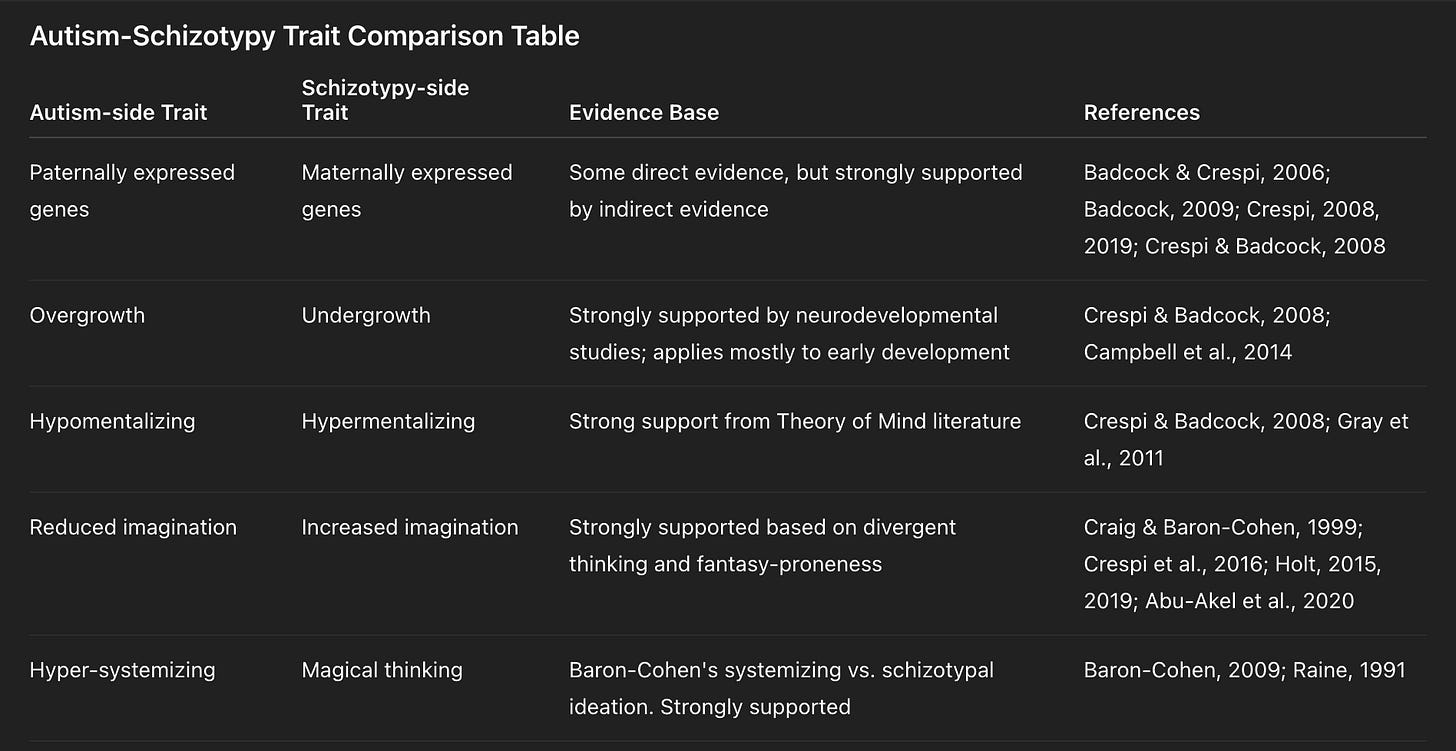
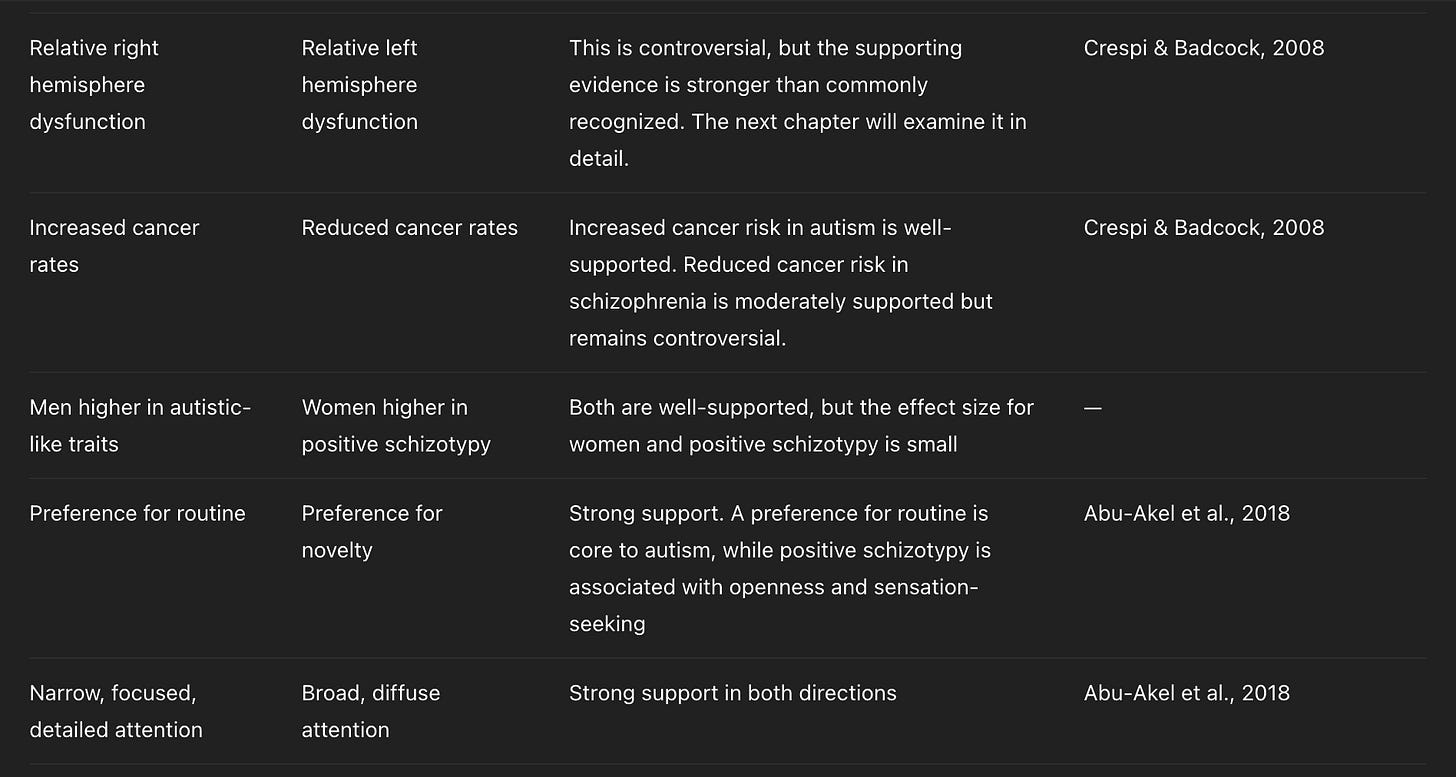
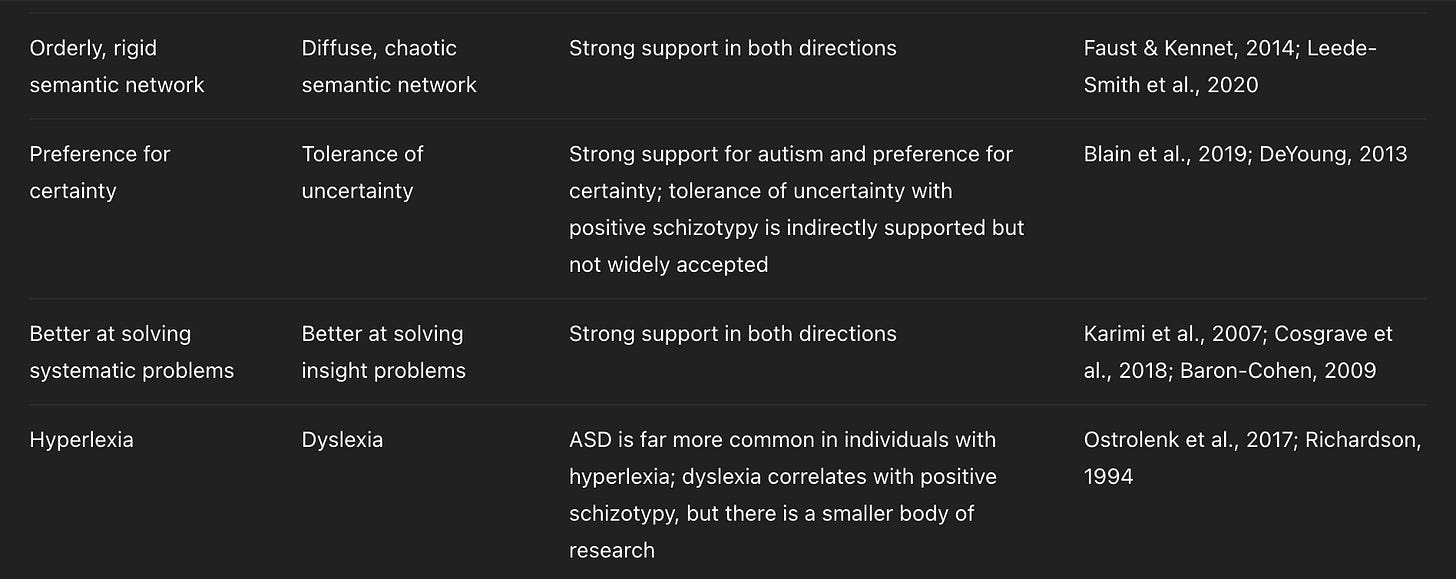
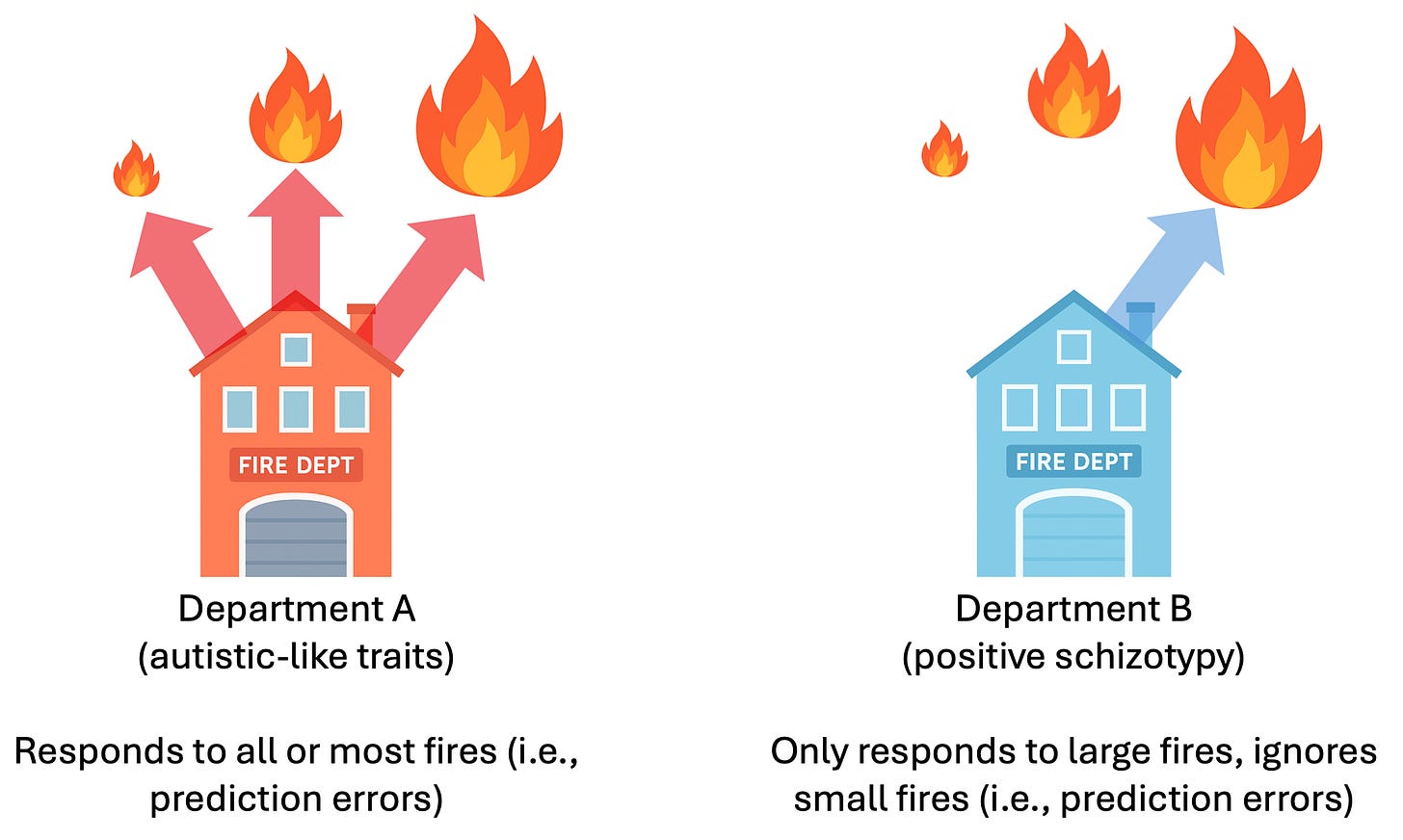
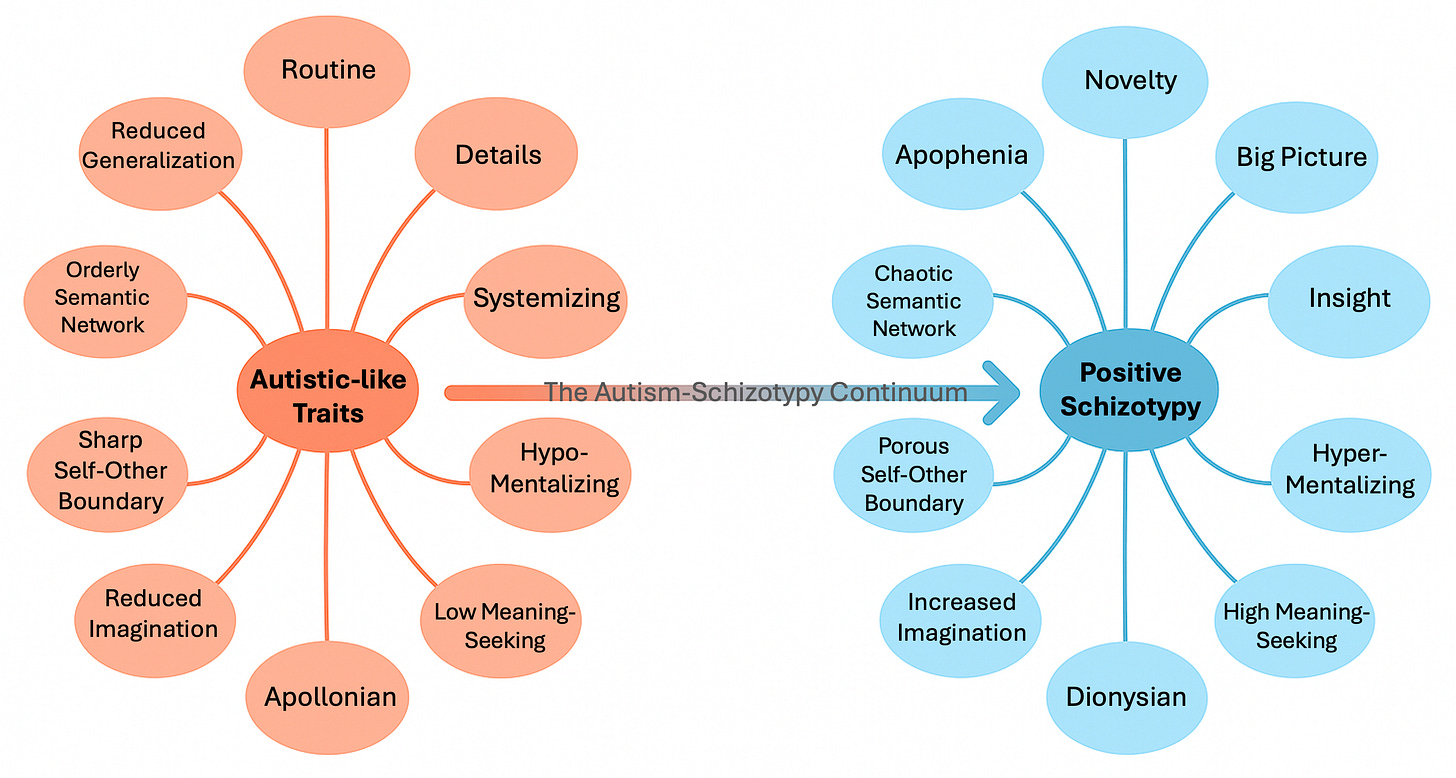

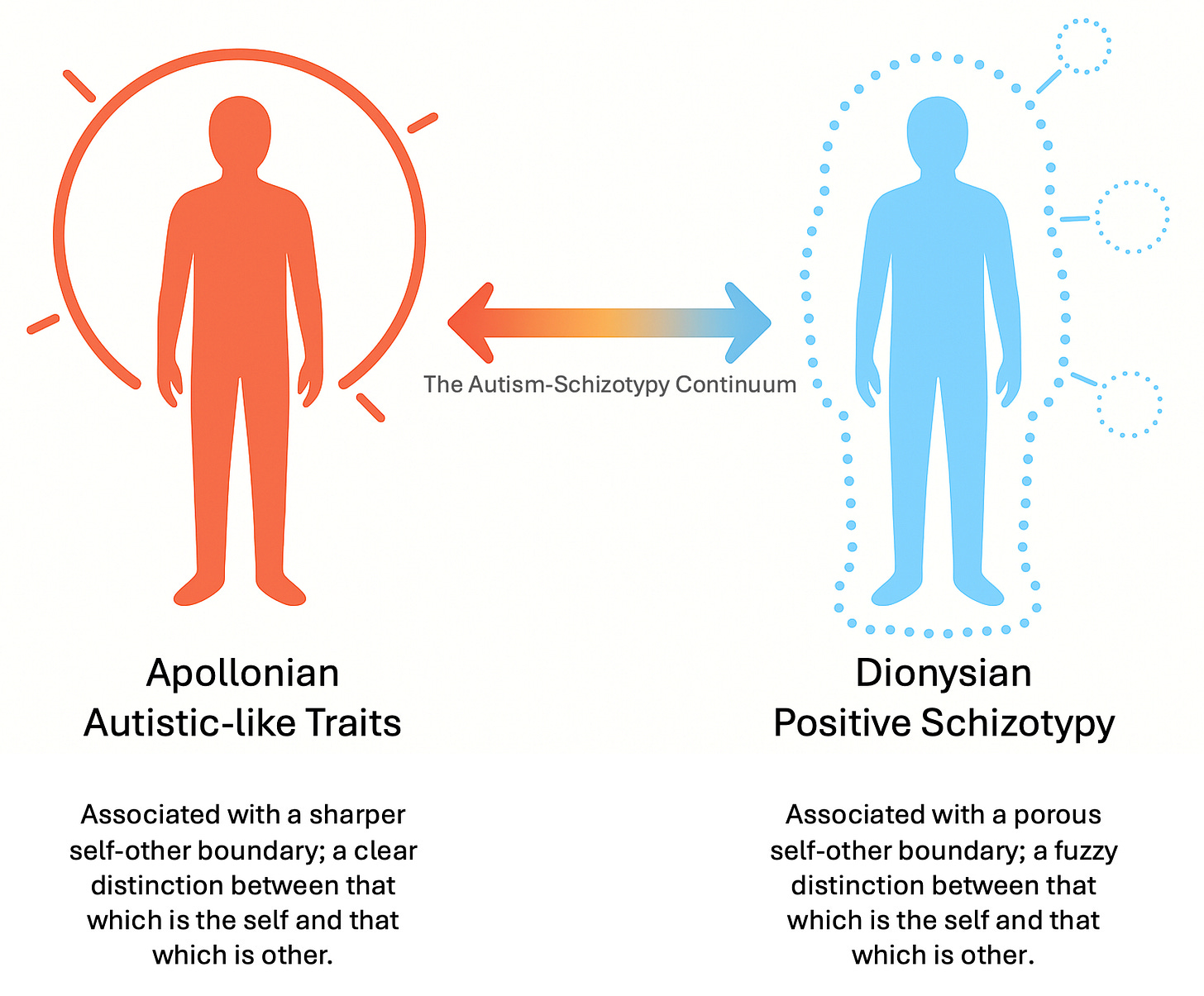

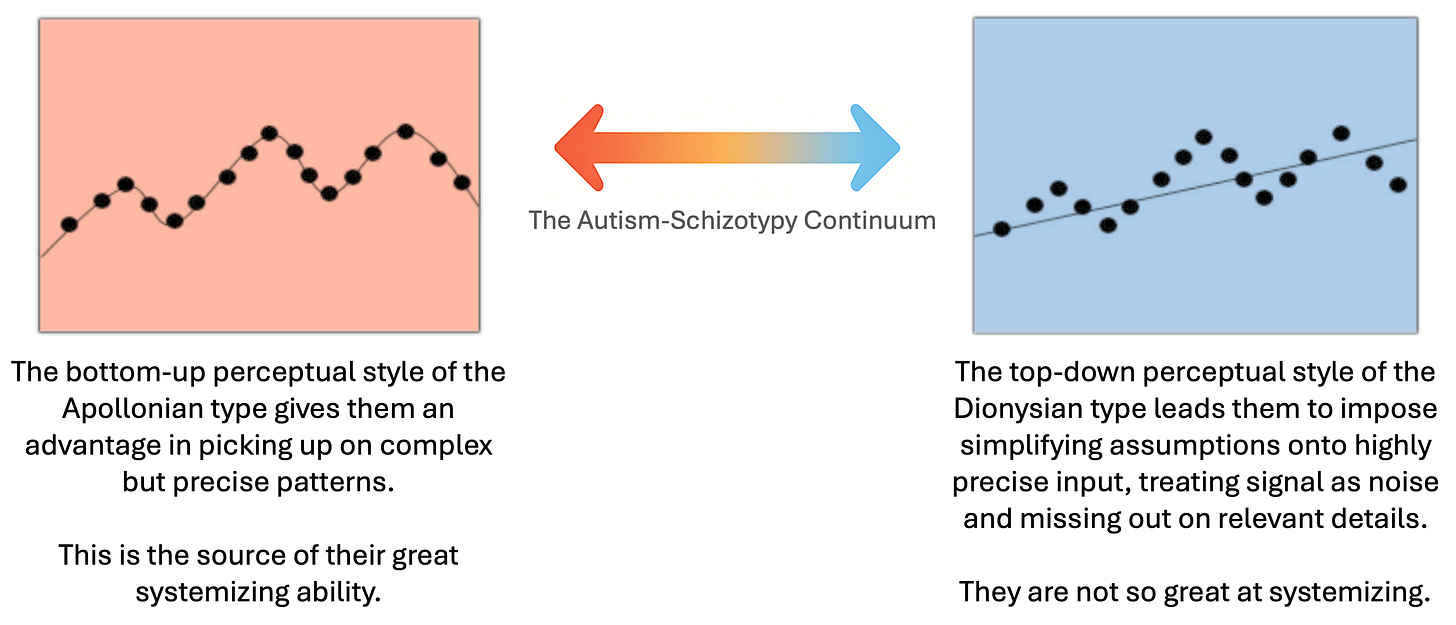

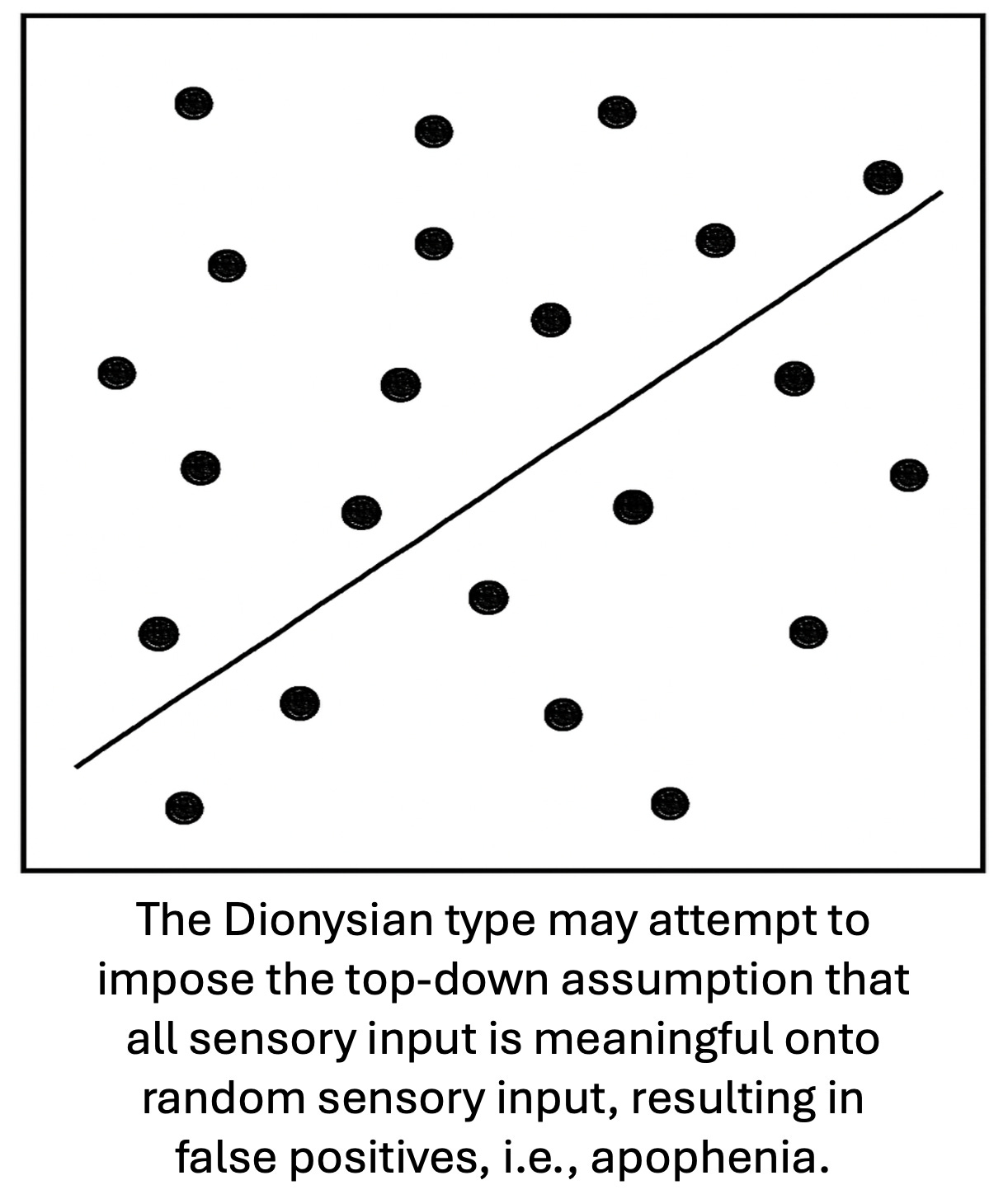

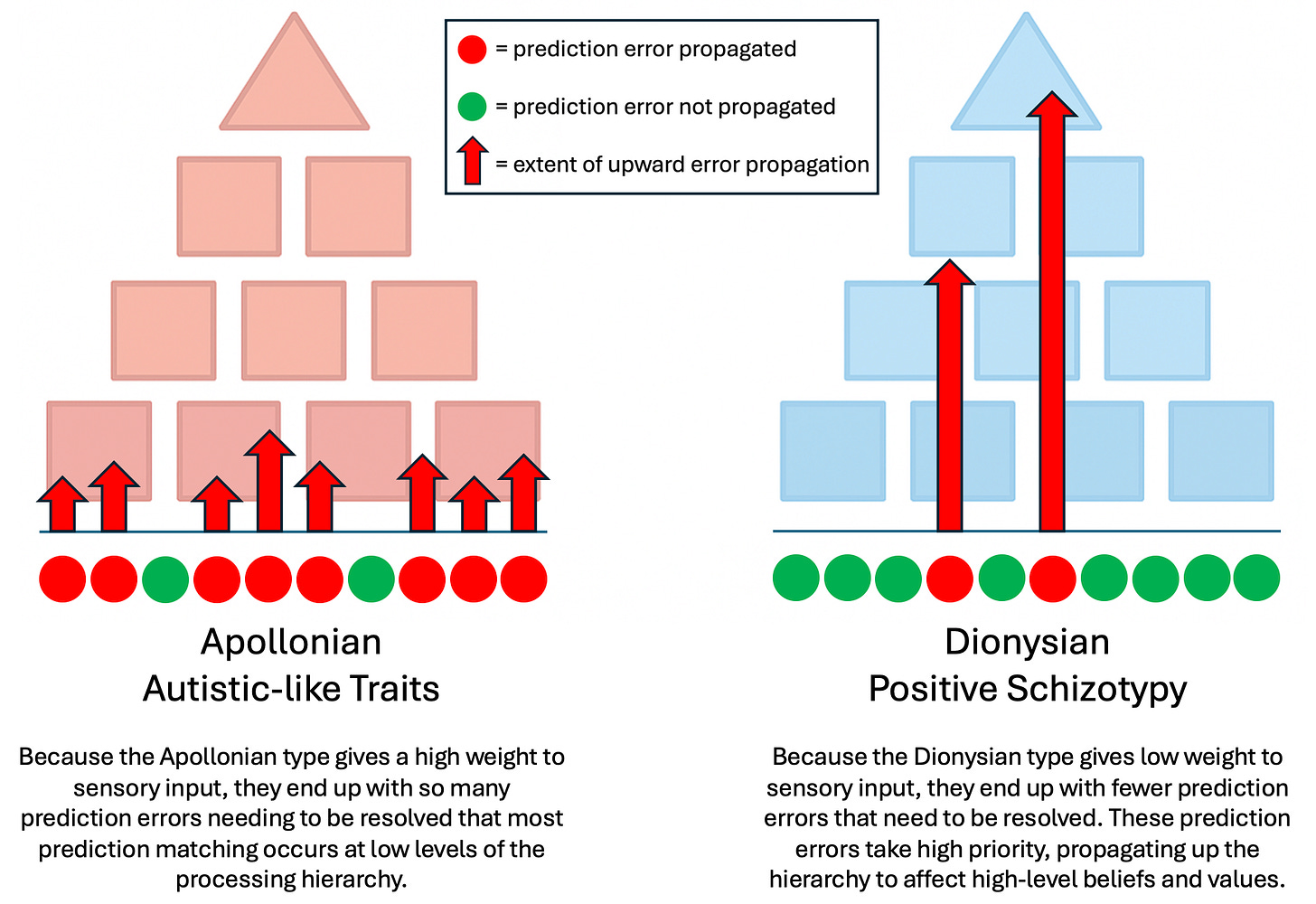

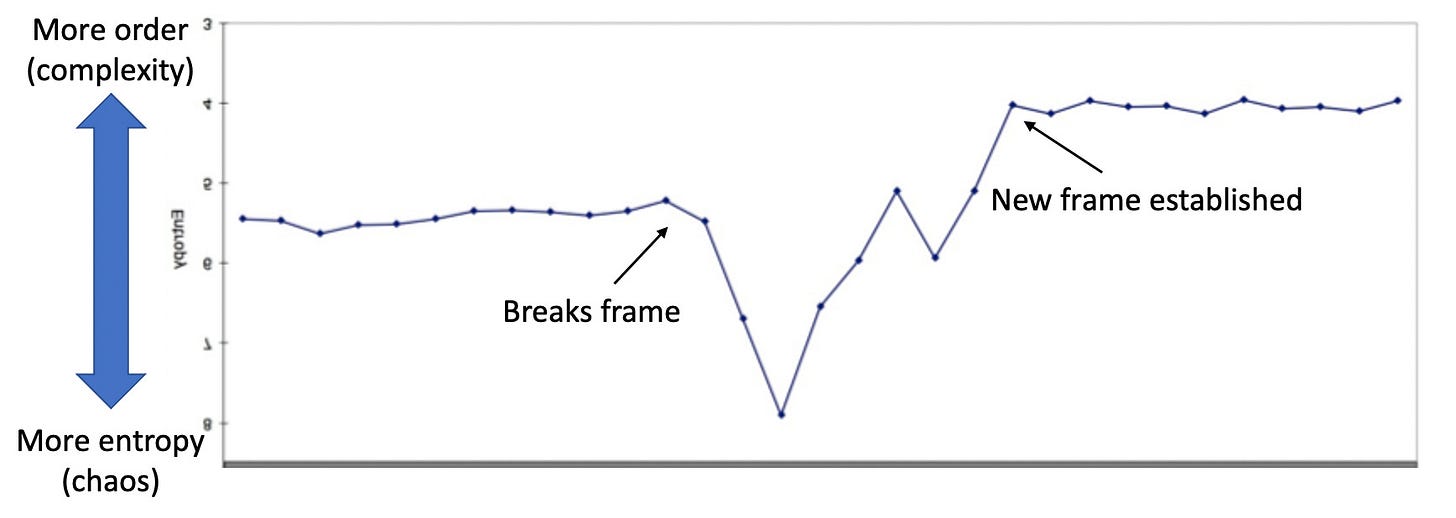
great article, thanks. going to link to it to provide a lot of the scientific backing “nerd shit i didnt feel like researching or typing” for an upcoming one on how autism relates to the schizo psycho war. the progression from psycho to autist to schizo (and then past schizo where you overcome the shadow and are now big chillin with superpowers - a mind without preference between creativity, quick rationality, and action itself) is literally the time circuit lmao. psychos remain instinctual. as we overcome our connection to the base animal instinct, we go too far into the human minds advantage and become autists. schizos get back to having high eq as well as decent iq, and so that duality (literally yin-yang the 7th hermetic principle) is beginning to get integrated. unfortunately they’re unironic so they still have fear so it is unpleasant